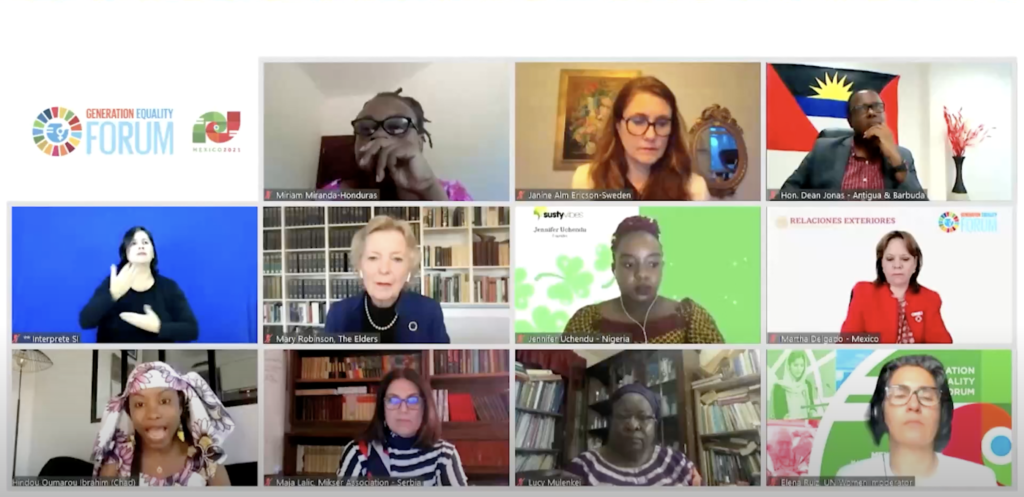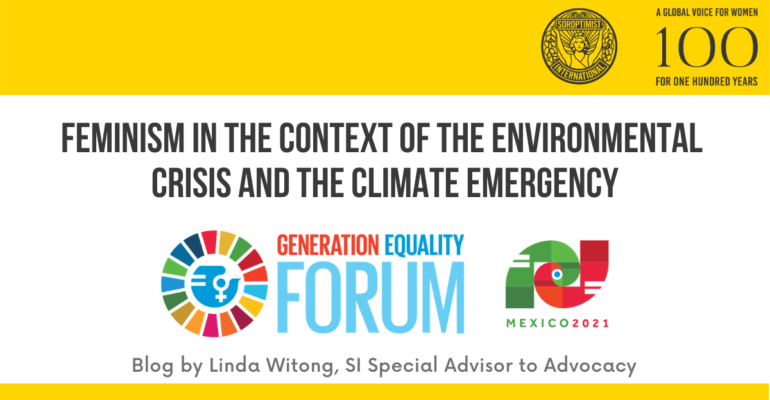Blog by Linda Witong, SI Special Advisor to Advocacy.
We have all witnessed the acceleration of environmental degradation and the increasing frequency, duration and intensity of extreme weather and climate events. We have been told that excessive or insufficient precipitation, rising sea levels, extreme temperature changes, and other climate hazards are only expected to intensify in all of our countries in the future. We have also learned that the vast majority of natural disasters are now water related, including drought, flood and tropical storms, which will have a significant impact on our societies, the economy and even our survival. All 15 of the world’s most war-torn countries are facing moderate to severe drought. Water scarcity could displace as many as 700 million people by 2030, and an increase in wildfires, a result of droughts, now emits pollution which is 10 times more harmful on human health than from other sources.
Even before the arrival of the COVID-19 pandemic, we were being educated about the health effects of global environmental change. We have been told that the loss of healthy life years in low income African countries is predicted to be 500 times that in Europe in the future. By the end of the century, the number of deaths resulting from climate change may also increase to 1.5 million per year if the rate of emissions remains unchanged. In an effort to escape the impact of the climate crisis, we are informed that people are being forced to move as a result of weather events and natural disasters at an average of 24.1 million people per year from 2008 to 2018.
But as ominous as this may all sound, while attending a Generation Equality Forum event entitled “Feminism in the Context of the Environmental Crisis and the Climate Emergency”, the audience learned that the cruel irony and injustice of climate change was that it had also created an unjust world which disproportionately impacts those who have contributed the least to global warming and who are amongst the world’s poorest and most marginalised groups. Climate change disproportionately impacted women: indigenous women or women of colour in particular. If the world continued its business as usual model, climate change would only increase the inequality between women and girls and the rest of the population. Climate feminism required that women be at the forefront in preventing this from occurring as well as creating and implementing just solutions for women and girls, and all of the inhabitants of the planet and its environment.

Screenshot taken from webinar.
We learned that women and girls are especially vulnerable to the effects of climate change due to the political, economic and social obstacles they face on a daily basis and their dependence on natural resources. Whether it is manifested as individual shocks or gradual environmental degradation, the effects of climate change are contributing to women and girls’ loss of lives and homes, poor health, and damage to the infrastructure, livelihoods and environmental resources they rely on. In extreme cases of flooding and coastal erosion, the physical survival of whole communities – or even nations in which they live, e.g. the case of small island developing States – may also be at stake.
The repercussions of climate change are severe for indigenous women or girls, many of whom already face social exclusion in addition to poverty; their reliance on natural resources for their living makes them markedly exposed and susceptible to climate change and its impacts.
We learned how indigenous women or girls were forced to watch as their way of life which had relied on traditional farming, foraging and hunting methods might no longer be effective due to the changing environment. Generations-old habits for planting crops might no longer be reliable and with their primary livelihoods increasingly under threat, indigenous peoples would be less able to generate produce needed to trade for goods that they lacked. Social and cultural identities of indigenous peoples were also strongly tied to the environments in which they have lived for generations. Climate change as well geoengineering or commercial developments threatened to accelerate the disappearance of some of these elements of identity and culture as well as the destruction of natural habitats.
The marginalisation faced by many indigenous peoples affected their ability to deal with the aspects of climate change, geoengineering or commercial development measures, since their needs were often not taken into account in climate mitigation and adaptation policymaking. In addition, they could also face institutional barriers to accessing resources and securing land tenure. Discrimination and, often, a lack of infrastructure in areas where many of them lived also made it challenging to obtain the loans and property rights that would facilitate a recovery of their way of life.
As indigenous women or girls watched their livelihood, cultural and physical heritage, access to food, clothing and shelter all being adversely effected or even eliminated by climate change, geoengineering, or commercial development measures, we have to ask: what does the future hold for many of them? According to the UN, 80% of people displaced by climate change were women or girls who are often pushed onto even more marginal lands, which were also often highly vulnerable to climate hazards.
Whether they are immediate or pan out over time, climate change impacts are felt both directly and indirectly on many women and girls’ livelihoods, health and mortality, agriculture and food prices, and labour productivity. These effects reinforce one another: the negative effects of a changing climate on health, agriculture, food prices and labour productivity may also undermine opportunities to make a living. The inability to sustain decent livelihoods, in turn, is likely to exacerbate the harmful health effects of climate change.
Policies have had an important role to play in addressing climate risks and building climate resilience. However, just as climate change impacts have been unevenly distributed, so too are policies built to counter them. Human rights depend on having a healthy biosphere. All women and girls have a human right to live in a healthy environment, the right to life, health, sufficient and nutritious food, clean and safe water and sanitation and sustainable housing. The negative impacts of climate change constitute a serious interference with the exercise of their fundamental human rights.
There is a direct relationship between gender equality, women’s empowerment and climate change. Soroptimist International is providing programmes and education which incorporate climate feminism, as we provide women with unique knowledge and skills that enable them to assume leadership positions as well respond to climate change in a more effective, just and sustainable way. At the local level, women’s inclusion at the leadership level as a result of our programmes has already led to improved outcomes of climate related projects and policies.
Developing countries – including small island developing States – face significantly higher climate-related risk and have fewer resources for mitigation or adaptation than developed countries. Many of these countries will find it increasingly difficult to recover from worsening climate conditions and more extreme events. In fact, unless appropriate action is taken which includes the participation of women and girls, climate change threatens to leave a substantial part of the world further behind. Please join Soroptimist International in ensuring that this does not happen.
To watch the recording of the event, click HERE.

